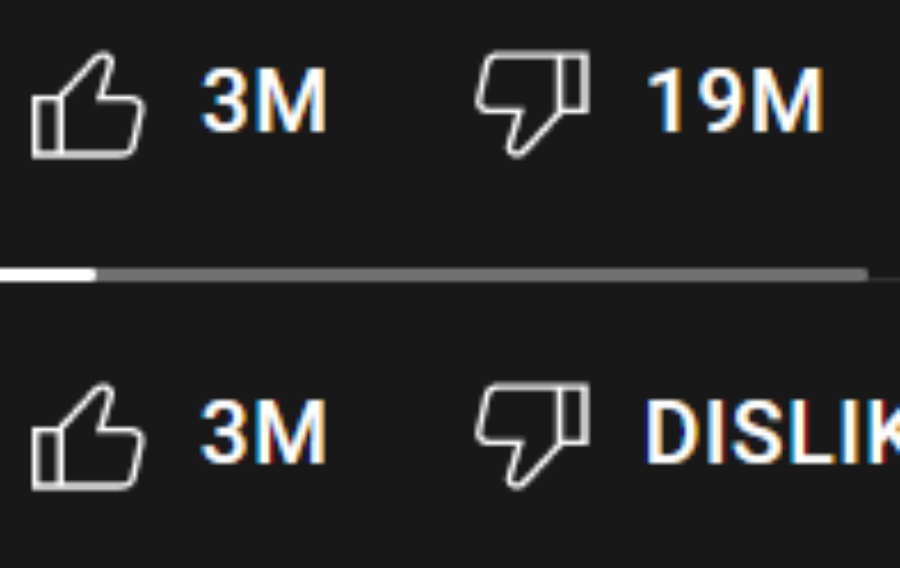
In an attempt to promote positivity on its platform, YouTube removed users’ ability to see the number of dislikes on a video. However, this decision has resulted in backlash from users and creators alike, and their anger is justified.
YouTube removed the dislike count mainly to protect content creators from “dislike attacks,” which happen when a group purposely works to drive up the number of dislikes on a video. “We want to create an inclusive and respectful environment where creators have the opportunity to succeed and feel safe to express themselves,” YouTube stated in a blog.
YouTube conducted an experiment in early 2021 in which they made the public dislike count private to help reduce the dislike attacks. After analysis, they found the attacks had reduced. After the positive results, in late November, YouTube made the final decision to remove the count from all users and rolled out the change to the platform.
But here is the problem: Removing the dislike count creates more issues than it resolves.
When the dislike button is removed, it deletes information vital to the users. YouTube had a feature where it would create a ratio bar right below the like and dislike buttons. This bar would indicate to users if the video would be worth their time.
For example, if a user was looking up a tutorial and then clicked on a video, if the like-to-dislike ratio was lower, users knew to go to the comments to see the reviews or to skip the video entirely so they would not have to spend their time scrubbing to see for themselves.
PV alum Aman Manazir has his own YouTube channel with over 2,000 subscribers. As a creator, he is disappointed in YouTube’s decision to remove important information from its users. “I think the YouTube dislike to like ratio gives valuable information to the viewer that helps them decide how seriously to take the video,” Manazir said. “That ratio is a great estimate as to how the audience as a whole reacts, and by removing it YouTube is concealing key information.”
Removing the dislike count could also lead to more negativity, which is what this move to remove the dislike count was initially aiming to resolve.
Marques Brownlee, also known as MKBHD, is a tech reviewer on YouTube with over 15 million subscribers. In his video titled “Dear Youtube” explaining why removing the dislike button is not a good idea, he stated that “removing the public counter just removes the scoreboard but then leaks the negativity into the comment section which is worse.” The other creators that MKBHD has talked to have shared that YouTube comment sections are where the bullying that YouTube is referencing occurs.
Another reason why YouTube removed the public dislike count is because “other platforms don’t even have a dislike button,” as stated by Matt Koval, Youtube’s Creator Liaison, in a video explaining the reasoning behind the decision.
Although this may be true, this is not a good reason for the change. After all, YouTube is not like other social platforms; it is the second largest search engine (after Google) on the Internet. People come to the platform for entertainment, recipes, tutorials and even education. So when crucial information such as the number of dislikes is unavailable to the user, its usability as a massive search engine decreases and thus diminishes the user experience.
The platform is also unlike other traditional platforms such as Twitter, Instagram and Facebook due to it being often categorized with video-streaming services such as Netflix, Amazon and Hulu. The only difference is its content is user-generated.
If users still cannot live without the dislike counter, there is some good news. Developers have temporarily created a browser extension in which users are able to see the dislike count for now. It is free and can be added to Chrome, Firefox, Edge, Opera and Brave. Do be warned that the extension may not work after Dec. 13 due to YouTube’s plans of removing the “dislike” field from its Application Programming Interface (API) on Dec. 13, meaning dislike counts will not be able to be accessed through the API after that date.
Although this decision to remove the public dislike count is universally disliked, it is understandable from YouTube’s perspective. Their mission is to give every creator on the platform a voice in a respectful environment. By removing the dislike button, they are ensuring that every creator can be heard and is free to express themselves without the fear of being harassed.
However, YouTube’s fault is not in trying to make a more respectful society but, rather, in making the largest video platform less usable. Removing the dislike button takes away the ability of everyone watching the video to provide crucial feedback on it, which makes the website more frustrating to use. This change begs the question of just how far YouTube is willing to go. What else on the platform will be put in jeopardy?








